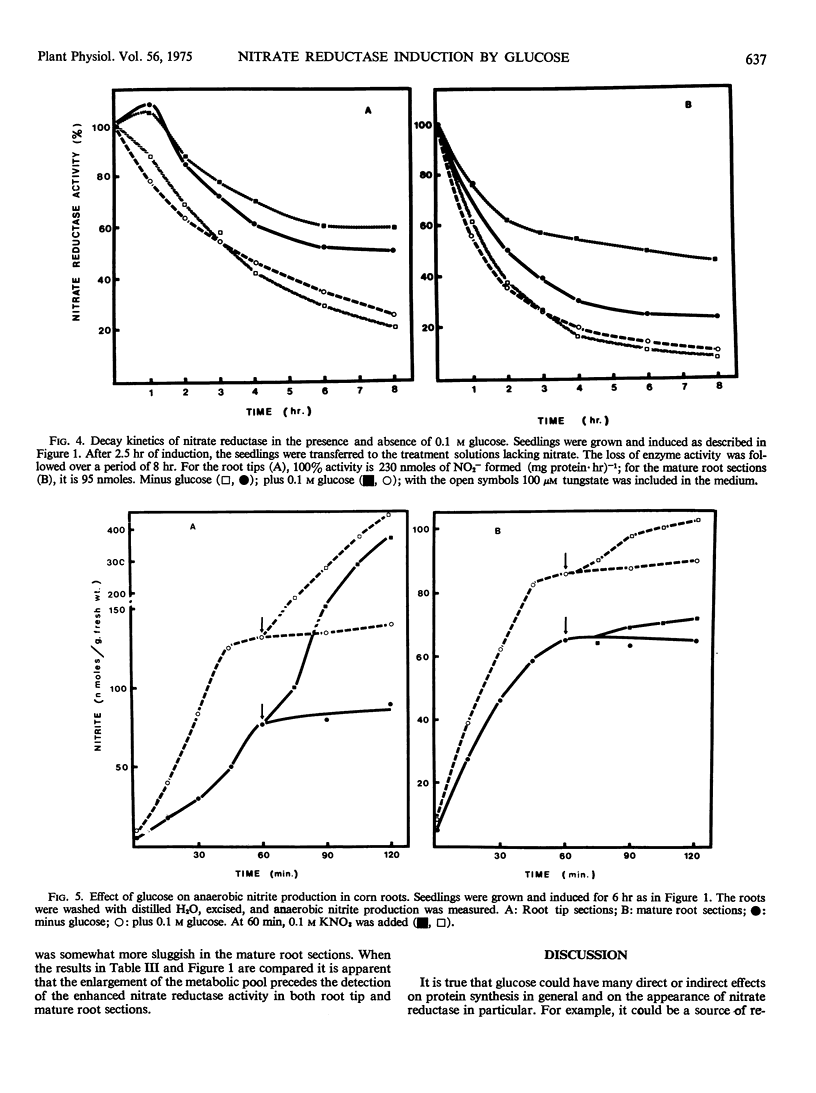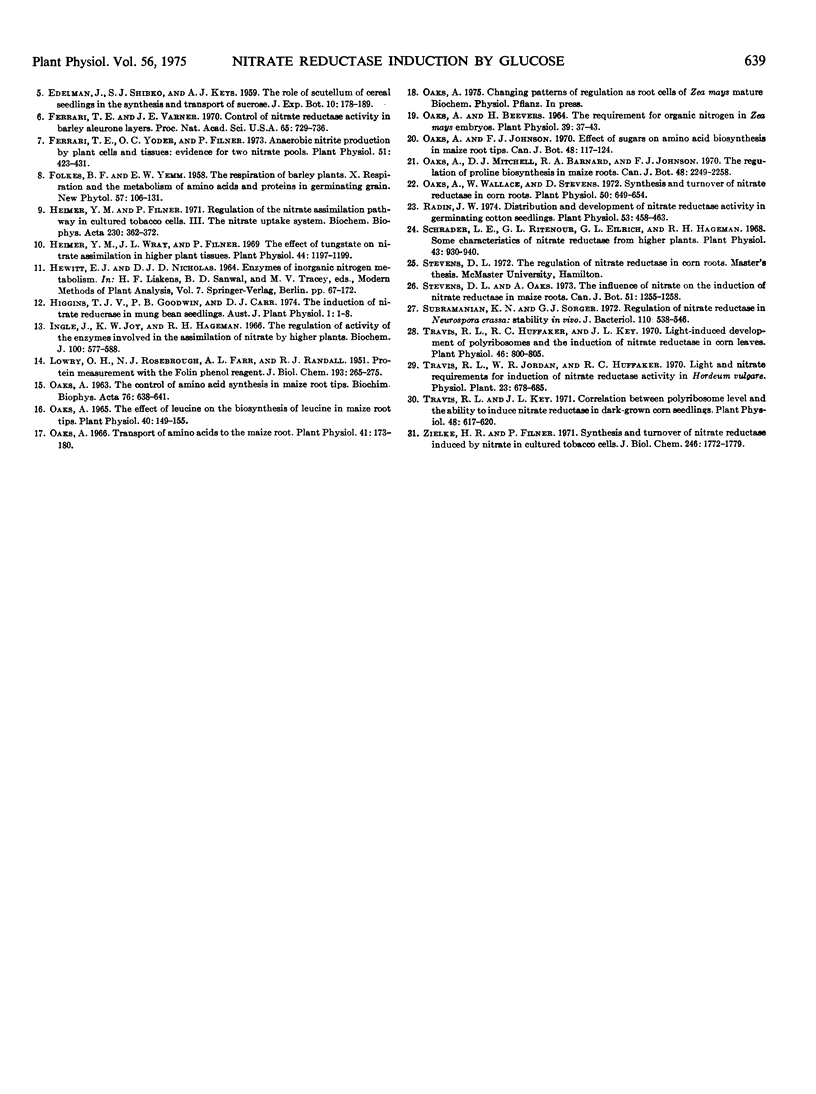Abstract
In Zea mays L., addition of glucose to the induction medium has no effect on the induction of nitrate reductase during the initial 3 hours either in root tips (0-10 mm) or mature root sections (25-35 mm). With longer times, higher levels of enzyme activity are recovered from both root segments when glucose is present in the incubation medium. The induction in root tips is saturated by 10 mm NO3−. Higher concentrations of NO3− are required for saturation in mature root sections. The response to glucose is seen over a wide range of external NO3− concentrations.
Nitrate reductase activity is lost rapidly when nitrate is withdrawn from the induction medium. Additions of glucose do not prevent this loss. Additions of glucose have no effect on total uptake of NO3− by the root segments but they increase the anaerobic NO2− production in both root tips and mature root segments. This latter measurement is considered to be an estimate of an active NO3− pool in the cytoplasm. Thus the results show that glucose alters the distribution of NO3− within the root sections. This may be an important factor in controlling the in vivo stability of the enzyme or its rate of synthesis.
Full text
PDF





Selected References
These references are in PubMed. This may not be the complete list of references from this article.
- Aslam M., Huffaker R. C., Travis R. L. The interaction of respiration and photosynthesis in induction of nitrate reductase activity. Plant Physiol. 1973 Aug;52(2):137–141. doi: 10.1104/pp.52.2.137. [DOI] [PMC free article] [PubMed] [Google Scholar]
- Beevers L., Schrader L. E., Flesher D., Hageman R. H. The Role of Light and Nitrate in the Induction of Nitrate Reductase in Radish Cotyledons and Maize Seedlings. Plant Physiol. 1965 Jul;40(4):691–698. doi: 10.1104/pp.40.4.691. [DOI] [PMC free article] [PubMed] [Google Scholar]
- Ferrari T. E., Varner J. E. Control of nitrate reductase activity in barley aleurone layers. Proc Natl Acad Sci U S A. 1970 Mar;65(3):729–736. doi: 10.1073/pnas.65.3.729. [DOI] [PMC free article] [PubMed] [Google Scholar]
- Ferrari T. E., Yoder O. C., Filner P. Anaerobic nitrite production by plant cells and tissues: evidence for two nitrate pools. Plant Physiol. 1973 Mar;51(3):423–431. doi: 10.1104/pp.51.3.423. [DOI] [PMC free article] [PubMed] [Google Scholar]
- Heimer Y. M., Filner P. Regulation of the nitrate assimilation pathway in cultured tobacco cells. 3. The nitrate uptake system. Biochim Biophys Acta. 1971 Feb 23;230(2):362–372. doi: 10.1016/0304-4165(71)90223-6. [DOI] [PubMed] [Google Scholar]
- Heimer Y. M., Wray J. L., Filner P. The effect of tungstate on nitrate assimilation in higher plant tissues. Plant Physiol. 1969 Aug;44(8):1197–1199. doi: 10.1104/pp.44.8.1197. [DOI] [PMC free article] [PubMed] [Google Scholar]
- Ingle J. The regulation of activity of the enzymes involved in the assimilation of nitrate by higher plants. Biochem J. 1966 Sep;100(3):577–588. doi: 10.1042/bj1000577. [DOI] [PMC free article] [PubMed] [Google Scholar]
- LOWRY O. H., ROSEBROUGH N. J., FARR A. L., RANDALL R. J. Protein measurement with the Folin phenol reagent. J Biol Chem. 1951 Nov;193(1):265–275. [PubMed] [Google Scholar]
- OAKS A. THE CONTROL OF AMINO ACID SYNTHESIS IN MAIZE ROOT TIPS. Biochim Biophys Acta. 1963 Dec 20;76:638–641. [PubMed] [Google Scholar]
- Oaks A., Beevers H. The Requirement for Organic Nitrogen in Zea mays Embryos. Plant Physiol. 1964 Jan;39(1):37–43. doi: 10.1104/pp.39.1.37. [DOI] [PMC free article] [PubMed] [Google Scholar]
- Oaks A. The effect of leucine on the biosynthesis of leucine in maize root tips. Plant Physiol. 1965 Jan;40(1):149–155. doi: 10.1104/pp.40.1.149. [DOI] [PMC free article] [PubMed] [Google Scholar]
- Oaks A. Transport of amino acids to the maize root. Plant Physiol. 1966 Jan;41(1):173–180. doi: 10.1104/pp.41.1.173. [DOI] [PMC free article] [PubMed] [Google Scholar]
- Oaks A., Wallace W., Stevens D. Synthesis and turnover of nitrate reductase in corn roots. Plant Physiol. 1972 Dec;50(6):649–654. doi: 10.1104/pp.50.6.649. [DOI] [PMC free article] [PubMed] [Google Scholar]
- Radin J. W. Distribution and development of nitrate reductase activity in germinating cotton seedlings. Plant Physiol. 1974 Mar;53(3):458–463. doi: 10.1104/pp.53.3.458. [DOI] [PMC free article] [PubMed] [Google Scholar]
- Schrader L. E., Ritenour G. L., Eilrich G. L., Hageman R. H. Some characteristics of nitrate reductase from higher plants. Plant Physiol. 1968 Jun;43(6):930–940. doi: 10.1104/pp.43.6.930. [DOI] [PMC free article] [PubMed] [Google Scholar]
- Subramanian K. N., Sorger G. J. Regulation of nitrate reductase in Neurospora crassa: stability in vivo. J Bacteriol. 1972 May;110(2):538–546. doi: 10.1128/jb.110.2.538-546.1972. [DOI] [PMC free article] [PubMed] [Google Scholar]
- Travis R. L., Huffaker R. C. Light-induced Development of Polyribosomes and the Induction of Nitrate Reductase in Corn Leaves. Plant Physiol. 1970 Dec;46(6):800–805. doi: 10.1104/pp.46.6.800. [DOI] [PMC free article] [PubMed] [Google Scholar]
- Travis R. L., Key J. L. Correlation between Polyribosome Level and the Ability to Induce Nitrate Reductase in Dark-grown Corn Seedlings. Plant Physiol. 1971 Nov;48(5):617–620. doi: 10.1104/pp.48.5.617. [DOI] [PMC free article] [PubMed] [Google Scholar]
- Zielke H. R., Filner P. Synthesis and turnover of nitrate reductase induced by nitrate in cultured tobacco cells. J Biol Chem. 1971 Mar 25;246(6):1772–1779. [PubMed] [Google Scholar]


